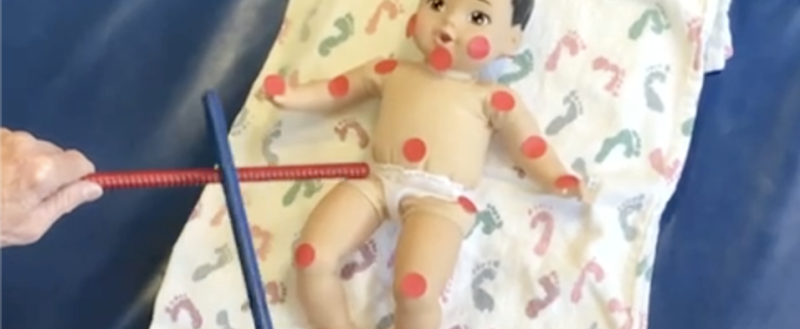
The Sensory Sticks are used to promote your baby’s neuro-development (motor skills, self-soothing behavior, sleep, eating, well-being, etc…)
Using the Sensory Sticks gently as described below will provide a low-level vibration to your child’s skin receptors which sends signals to your child’s brain. This low-level vibration will enhance your child’s proprioception which is the body’s awareness of its position in space. This helps your child discover how all their body parts are connected. When the infant is aware of how their body parts work together, they will be more content, sleep and eat better. A happier infant/toddler. The Sensory Sticks promote the baby’s health and parent’s peace!
Who Benefits?
All infants! However, if your child was born via c-section, had a complicated birth, spent time in the NICU, had low APGAR scores, or has low muscle tone this will help promote their development.
When do I use the sticks?
It is recommended that you get in the habit applying the sticks to you baby after you change their diaper and while their clothes are off.
Where do I get the sticks?
Ted Brown Music Store in Tacoma, WA or Amazon.
How do I use the Sensory Sticks with my baby?
Watch this video:
A Letter to New Parents and Grandparents
Your developing infant has started on a journey of self-discovery. She/he has been equipped with a fantastic bundle of neurological potential. What I want you to know is they will need your help to harness their potential. One component is their ability to become self-aware of their body which they will need for life. In the days/months ahead, their increasing self-awareness will lead them to be better able to calm/self-sooth themselves. When this happens, they often become better sleepers as well as
“their parents.”
Your infant/toddler is figuring out how to connect all their body parts with your help. To assist your child along in this process we are introducing to you the “Sensory Sticks.” The Sensory Sticks when provided to your child’s body will provide a low level of vibratory input enhancing their proprioception (their body’s sense of position/movement). Just like us adults, when we feel comfortable knowing where we are we will trend to being more relaxed.
Providing this enhanced touch perception to your child will enhance their well being and our hope is that it will reduce their crying, fussing, improve their sleep and possibly help with their feeding/latching for breast feeding. I am encouraging parents to use the Sensory Sticks when you change their child’s diapers. The entire sequence can be done in less than a minute but I would highly recommend that you set your own pace while reading your child’s cues.
When is it time for Sensory Sticks: at diaper change. The “ribbed” stick is placed in contact with the child’s skin (using approximately the same amount of pressure as you would to make an indentation in a balloon). The other stick is rubbed on the ribbed stick at a comfortable pace for the parent (see video above).
Our goal is to make this a “habit” for the parent. You can enhance your child’s entire nervous system in a couple minutes. The duration at each body part can be brief 3-5 seconds. I encourage parents to name each body part as the input is provided i.e. “This is your knee, here is your belly, this is your chin, …” Decide which foot you want to start with and do that entire side working your way up (include belly & chin), then move onto the other foot/side (plus belly/chin). The sequence I recommend: foot-knee-hip-belly-shoulder-elbow-hand-cheek-chin-behind the ear. Fantastic!
I starting using Sensory Sticks with kids in 1988 while working with Karen New, LPT at Cape May County Early Intervention Program. This intervention was her idea. I have purchased hundreds of pairs of sticks over my therapy years and have used them with a variety of children, not just infants/toddlers. It is beyond time for me to share with everyone some “OT Techniques” which I have found to have a positive effect on a child’s development/well-being.
Wishing you much success,
John Murray and the Murray Therapy OT team